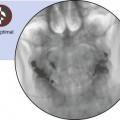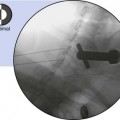Chapter 30 Cervical Spinal Cord Stimulation
Note: Please see page ii for a list of anatomical terms/abbreviations used in this book.
Access to the cervical interlaminar space may be obtained from between C7-T1 through T2-T3.
 Trajectory View (Figure 30–1)
Trajectory View (Figure 30–1)
 Confirm the appropriate interlaminar space with the anteroposterior view. (We demonstrate T1-2 here.)
Confirm the appropriate interlaminar space with the anteroposterior view. (We demonstrate T1-2 here.)
 Maintain your marker at the appropriate interlaminar space and tilt the C-arm image intensifier as caudally as possible to obtain the trajectory view.
Maintain your marker at the appropriate interlaminar space and tilt the C-arm image intensifier as caudally as possible to obtain the trajectory view.
 Slightly oblique the C-arm contralateral to the symptomatic side so that the introducer will be set up to help guide the stimulator lead. The lead will have a tendency to travel contralateral to the side of entry, thereby making this technique an efficient method for facilitating proper lead positioning.
Slightly oblique the C-arm contralateral to the symptomatic side so that the introducer will be set up to help guide the stimulator lead. The lead will have a tendency to travel contralateral to the side of entry, thereby making this technique an efficient method for facilitating proper lead positioning.
 Anesthetize the skin over the interlaminar space (T1-2 demonstrated here), and use an 18-gauge, 1.5 inch needle to dilate the skin.
Anesthetize the skin over the interlaminar space (T1-2 demonstrated here), and use an 18-gauge, 1.5 inch needle to dilate the skin.
 Remove the 18-gauge needle, and use the introducer needle to obtain the trajectory needle view.
Remove the 18-gauge needle, and use the introducer needle to obtain the trajectory needle view.
 Because this is the trajectory view, the needle entry position should be parallel to the C-arm beam.
Because this is the trajectory view, the needle entry position should be parallel to the C-arm beam.
 Note that the angle of the needle is as shallow as possible, as described in this chapter’s introduction.
Note that the angle of the needle is as shallow as possible, as described in this chapter’s introduction.
Stay updated, free articles. Join our Telegram channel

Full access? Get Clinical Tree




